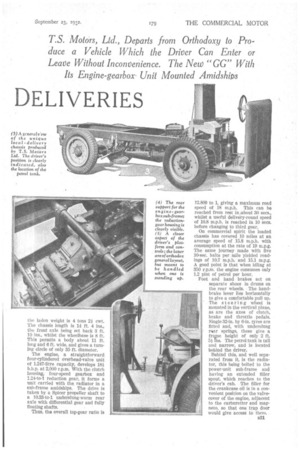A NEW 2-TONNER
Page 48

Page 49

If you've noticed an error in this article please click here to report it so we can fix it.
designed essentially
FOR LOCAL
DELIVERIES
T.S. Motors, Ltd., Departs from Orthodoxy to Pro duce a Vehicle Which the Driver Can Enter or
Leave Without Inconvenience. The New "GG" With
Its Engine-gearbox. Unit Mounted Amidships
AFTER a period of road trial T.S. Motors, Ltd., Maidstone, announces the introduction of a new local-delivery 2-tonner, and The Commercial Motor offers its readers the first full description of what is a most unorthodox and striking chassis.
The aim has been to design a transport unit to meet the special needs of short-distance delivery work In areas of congested traffic. Two leading requirements, obviously, were easy ingress and egress for the driver, and the lowest possible petrol consumption commensurate with work involving a large number of halts. It may be mentioned that Carter, Paterson and Co.. Ltd., closely concerned with these very prOblems, has collaborated with T.S. Motors, Ltd., in the production of the new machine.
Appropriately designated the GG type, this 2-tormer has its enginegearbox unit mounted low between the frame-members amidships, the body being mounted above it. The frame is downswept before the front axle to provide a driver's platform not more than 15 ins, from the ground. A cab may be fitted to afford weather protection, but doors would normally be dispensed with.
A more suitable position for the driver, who also is a local rounds
man, could scarcely be conceived. Accessibility of the controls and ease of operation are other objects that have been considered, and it is, therefore, not considered that the man should sit down when driving. A rest, which will take part of his weight, is fitted, but the controls are arranged so as to be handled easily when standing, thus reducing still further the time taken to get into and out of the vehicle.
An electric starter can be fitted, but hand starting is rendered such a quick and easy matter that it is anticipated the electric equipment will ordinarily be unnecessary. The starting handle is actually located in the cab, and as the engine is a fourcylindered petrol unit of only 10 h.p. rating the sharp pull-up . needed should not occupy more than a second.
After a glance at the accompanying illustrations readers may be in doubt as to engine accessibility. Detachable floorboards or wide trapdoors give fairly easy access to both slues of the power unit, whilst owners of big fleets will no doubt tit lift-van bodies which can he quickly slung off if engine attention be called for. In fact, quite a promising scope exists for such a machine as this in the conveyance of lift vans to and from docks and railway yards. Another field of usefulness is in refuse collection. In this case the body would be equipped for tipping, so that engine accessibility would be assured. Even for the small tradesman it may be assumed that the body would be light and easily detached.
The G G chassis weighs 1 ton 9 cwt., so that, allowing 33f cwt. for the bodywork and the driver and 2 tons for pay-load, the laden weight is 4 tons 21 cwt. The chassis length is 14 ft. 4 ins., the front axle being set back 3 ft. 10 ins., whilst the wheelbase is 8 ft. This permits a body about 11 ft. long and 6 ft. wide, and gives a turning circle of only 35 ft. diameter.
The engine, a straightforward four-cylindered overhead-valve unit of 1.247-litre capacity, develops 18?, b.h.p. at 2,000 r.p.m. With the clutch housing, four-speed gearbox and 1.24-to-i reduction gear, it forms a unit carried with the, radiator in a sub-frame amidships. The drive is taken by a Spicer propeller shaft to a 10.33-to-1 underslung-worm rear axle with differential gear and fully floating shafts.
Thus, the overall top-gear ratio is 12.809 to 1, giving a maximum road speed of 18 m.p.h. This can be reached from rest in ,about 30 secs., whilst a useful delivery-round speed of 10.8 m.p.h. is reached in 10 secs, before changing to third gear.
On commercial spirit the loaded chassis has covered 10 miles at an average speed of 15.8 m.p.h. with consumption at the rate of 19 m.p.g. The same 'journey made with five 10-sec. halts per mile 'yielded readings of . 10.7 m.p.h.' and 15.1 m.p.g. A good point is that when idling at 350 r.p.m. the engine consumes only 1..2 pint of petrol per hour.
Foot and hand brakes act on separate shoes in .drums on the rear wheels. . The handbrake lever lies horizontally to give a comfortable pull up. The steering Wheel is mounted in the vertical plane, as are the axes of clutch, brake and throttle pedals. Single 32-in. by 6-in. tyres are fitted and, with unclerslung rq.ar springs, these give a fraine height of only 2 ft. ms. The petrol.tank is tall and narrow, aud is located behind the driver.
Behind this, and well separated from it, is the radiator, this being bolted to the power-unit sub-frame and having an extended filler spout, which reaches to the driver's cab. The filler for the crankcase oil is in a convenient position on the valvecover of the engine, adjacent to the carburetter and magneto, so that one .trap. door would give access to them.






































































































